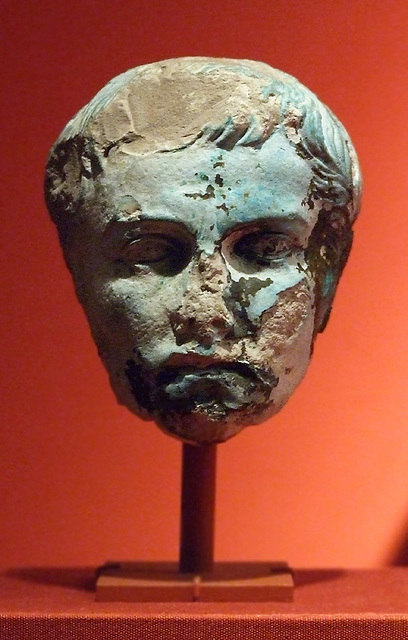Detail of Aphrodite Rising from the Bath in the Me…
Decorated Jar in the Metropolitan Museum of Art, M…
Lamp with Athena / Neith in the Metropolitan Museu…
Harpokrates with Double Crown, Cornucopia, and Pot…
Palm of a Ceremonial Fan in the Metropolitan Museu…
Bracelet in the Metropolitan Museum of Art, March…
Decorative Attachment in the Form of a Head of Med…
Plaque Representing an Egyptian Kiosk in the Metro…
Skyphos with Laurel Sprays on the Body in the Metr…
Tablet Dedicated to Thoth in the Metropolitan Muse…
Plaque Representing a Greco-Roman Type Temple with…
Mask of a Woman with Ball Earrings, Corkscrew Lock…
Odalisque with Gray Trousers by Matisse in the Met…
Detail of Odalisque with Gray Trousers by Matisse…
Self Portrait by Boccioni in the Metropolitan Muse…
Reclining Nude by Modigliani in the Metropolitan M…
Self Portrait by Picasso in the Metropolitan Museu…
Self Portrait by Picasso in the Metropolitan Museu…
Gray Weather, Grand Jatte by Seurat in the Metropo…
Detail of Gray Weather, Grand Jatte by Seurat in t…
Circus Sideshow by Seurat in the Metropolitan Muse…
Hyacinthe-Eugene Meunier by Renoir in the Metropol…
Vetheuil in Summer by Monet in the Metropolitan Mu…
Marble Fragment of a Stele of a Youth in the Metro…
Bronze Shepherd in the Metropolitan Museum of Art,…
Fragmentary Bronze Statuette of a Woman in the Met…
Bronze Mirror Support in the Form of a Girl in the…
Mosaic Glass Unguentarium in the Metropolitan Muse…
Glass Cinerary Urn and Ashes in the Metropolitan M…
Bronze Mirror with a Support in the Form of a Drap…
Gold-Glass Mosaic Bowl in the Metropolitan Museum…
Hellenistic Greek Glass Bowl in the Metropolitan M…
Glass Cup in the Form of a Head of an African in t…
Two Gold Pendant Disks in the Metropolitan Museum…
Gold Pendant in the Form of a Gorgoneion in the Me…
Pair of Gold Earrings with a Disk and Eros in the…
Silver Bracelet with Ram's Head Finials in the Met…
Terracotta Column Krater Attributed to the Orchard…
Detail of a Terracotta Column Krater Attributed to…
Detail of a Terracotta Squat Lekythos Attributed t…
Terracotta Squat Lekythos Attributed to an Artist…
Detail of a Seated Buddha in the Metropolitan Muse…
Seated Buddha in the Metropolitan Museum of Art, A…
Detail of a Female Dancer in the Metropolitan Muse…
Female Dancer in the Metropolitan Museum of Art, A…
Location
Lat, Lng:
You can copy the above to your favourite mapping app.
Address: unknown
You can copy the above to your favourite mapping app.
Address: unknown
See also...
Keywords
Authorizations, license
-
Visible by: Everyone -
All rights reserved
-
491 visits
Head of Augustus in the Metropolitan Museum of Art, March 2010


Head of Augustus, Roman Period, 27–20 b.c.
Egyptian
Blue-green (glassy?) faience
H. 2 5/8 in. (6.8 cm)
Purchase, Edward S. Harkness Gift, 1926 (26.7.1428)
With the defeat of Cleopatra VII and Marc Antony at the Battle of Actium in 31 B.C., Egypt became a Roman province under the direct control of the Roman emperor. Augustus assumed the traditional divine role of pharaoh in Egypt, portraying himself as the offspring of the gods. He made numerous additions to the major temples of Egypt and founded the Temple of Dendur. His administrative reforms brought economic and political stability to Egypt after the turmoil of the Ptolemaic era.
This small head from Memphis may have come from a statue dedicated to the cult of the emperor. The style is completely Roman and is similar to other portraits from early in his long reign. The choice of blue-green faience, however, reflects the Egyptian attributes of longevity and prosperity.
Text from: www.metmuseum.org/toah/works-of-art/26.7.1428
Egyptian
Blue-green (glassy?) faience
H. 2 5/8 in. (6.8 cm)
Purchase, Edward S. Harkness Gift, 1926 (26.7.1428)
With the defeat of Cleopatra VII and Marc Antony at the Battle of Actium in 31 B.C., Egypt became a Roman province under the direct control of the Roman emperor. Augustus assumed the traditional divine role of pharaoh in Egypt, portraying himself as the offspring of the gods. He made numerous additions to the major temples of Egypt and founded the Temple of Dendur. His administrative reforms brought economic and political stability to Egypt after the turmoil of the Ptolemaic era.
This small head from Memphis may have come from a statue dedicated to the cult of the emperor. The style is completely Roman and is similar to other portraits from early in his long reign. The choice of blue-green faience, however, reflects the Egyptian attributes of longevity and prosperity.
Text from: www.metmuseum.org/toah/works-of-art/26.7.1428
- Keyboard shortcuts:
Jump to top
RSS feed- Latest comments - Subscribe to the comment feeds of this photo
- ipernity © 2007-2025
- Help & Contact
|
Club news
|
About ipernity
|
History |
ipernity Club & Prices |
Guide of good conduct
Donate | Group guidelines | Privacy policy | Terms of use | Statutes | In memoria -
Facebook
Twitter

Sign-in to write a comment.